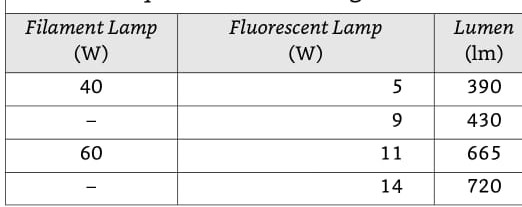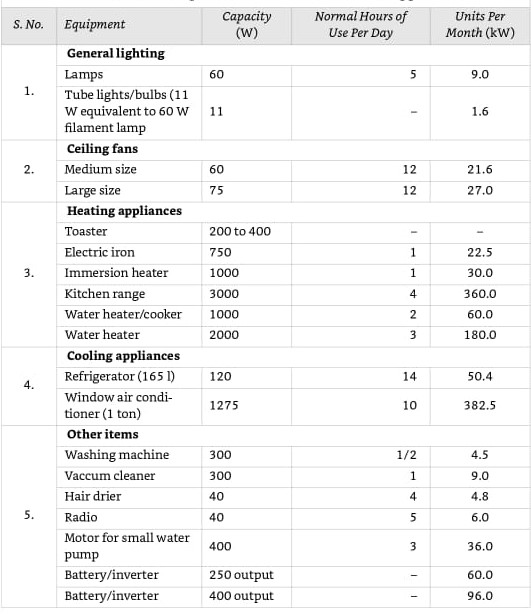Some Fundamentals on Home Electricals
We pay for our electricity charges in kilowatt-hours. In electrical engineering, the power of an item is expressed in watts (W) and it is related to the voltage [in volts (V)] and the current [in ampere (A)] as follows:
W = V × A
Thus, if we use a 15 A fuse with a current of 220 V, the fuse can stand up to a power of 220 × 15 = 3300 W (3.3 kW) only. In fact, we generally do not allow the total connected load per fuse to be more than 3 kW. Hence, in general, we use only 13 A–15 A fuse in each of the circuits in a building.
Note Capacities of electrical systems like inverters, and solar panels are expressed in kilowatts (kW) or kilovolt ampere (kVA).
Load Rating of Lighting Devices Used in Buildings
For lighting in the building, we may use
1. Tungsten filament lamp of different wattage
2. Fluorescent lamps of different wattages [These lamps consume only 20% of the current consumed by that the filament lamps for the same brightness. Nowadays, compact fluorescent lamps (CFLs) are also available that are to be fitted into the sockets like the old electric bulbs.]
3. Flood light lamps
4. Other special lamps
The brightness of a lamp is expressed in a unit called Lumen (lm). The relationship given in the Table below can be taken when we consider electric lighting.
Table: Relationship of wattage and lumen
The equivalence in wattage of filament lamps and fluorescent lamps for lighting is shown in the Table below
Table: Equivalence in wattage and lumen
(Note: The unit of electricity based on which we pay charges is a kilowatt hour (kWh). One 25 W lamp burning for 40 hours consumes only 1 kWh or one unit of electricity. Hence, it is not the lighting of a house that consumes much current, but it is the electric machines like refrigerators, air conditioners, ovens, etc. that consume more current (see Table below)
From the Table above, fluorescent lamps are much more economical to use than ordinary filament lamps. However, fluorescent lamps should not be used in enclosed fittings or exposed to water or rain and should not be used in dimming circuits.
Load Rating of Usual Household Appliances
The load (in watts) of the common household appliances we use is given in the Table below.
Lighting and Power Circuits
Electric supply in a building is to be made not only for general lighting but also for electrical equipment like refrigerators, air conditioners, etc. We will see that connections to various types of devices are made by different circuits known as the lighting circuit, power circuit, and fixed appliance circuits.
Lighting circuits
Low-wattage units like lights can be connected by two wires: one phase and the neutral. However, the most commonly used is the three-wire circuit system as shown in the Figure below. It is known as the loop-in method. It uses an earthed twin cable and a circuit breaker on the fuse protection device also.
Figure: Lighting circuit wiring diagram of the loop in method (N = Neutral, L = Live, E = Earth); 1. A consumer control unit (mains switchboard), 2. Ceiling rose, 3. One-way switch, 4. Lamp, 5. Two-way switch.)
Power circuits
Equipment (like refrigerators, and water pumps) of not very high wattage are connected to the three-wire system. These are called power circuits, as shown in the Figure below. Switches of the lighting circuits and sockets of power circuits are placed on the same switchboard.
Fixed appliance circuits
These are the circuits for individual units like an air conditioner with high wattage. These should be always earthed. It is interesting to examine how earthing of equipment adds to its safety. We have the relation V = IR, where V is the voltage in volts (V), I is the current in amperes (A), and R is the resistances in ohms (W). If there is any leakage of electricity, then because of earthing the resistance R becomes small and the amperes of current I become very large. This blows out
Figure: Power circuit wiring diagram: Ring main wiring (N = Neutral, L = Live, E = Earth); 1. The consumer control unit, 2. 15 A socket outlets in ring main, 3. 15 A spur socket outlet.)
the 15 A fuse we have put in the circuit at the switchboard. This switches off the current and the equipment remains safe. Note: The above explanation shows that it is very important that we should not put more than 15 A fuse in these circuits for home appliances. Only the main fuse connecting to the external supply is to be high, usually 100 A.












Choose the best IPTV subscription for unparalleled entertainment. Enjoy thousands of channels, crystal-clear quality, and user-friendly features on various devices. Experience top-notch service with 24/7 customer support. Elevate your viewing experience today.
ReplyDelete"The lighting fixtures in this kitchen are truly a work of art." custom cabinetry
ReplyDeleteLoving the gallery wall in this living room. It's a great way to showcase art. interior design firm in Potomac, MD
ReplyDelete